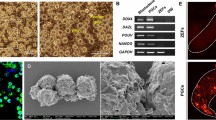Abstract
SINCE the experiments of Briggs and King1, in which nuclei from blastula cells were transplanted by microinjection into enucleated frogs' eggs, the technique of nuclear transplantation has been used extensively to study interactions between nucleus and cytoplasm during differentiation in amphibians2–5. But severe difficulties are encountered in attempts to apply this technique to the mammalian egg. The rabbit egg, with a diameter of 100 µm, is 1,000 times smaller in volume than a frog's egg, and the mouse egg has a volume one-third that of a rabbit's egg. An alternative, and technically easier method of transplanting a nucleus is by inducing fusion of an egg and a cell with Sendai virus. The technique of virus-induced fusion, originally developed for hybridising somatic cells6–7, has been adapted to fuse somatic cells with unfertilised or fertilised mouse eggs8–13. Although Sendai virus was shown not to harm mouse embryos in these experiments, and cells were successfully fused, the transplanted nuclei did not survive. Unfertilised mouse eggs which were fused with cells from embryos at the 2–8-cell stage failed to cleave8.
This is a preview of subscription content, access via your institution
Access options
Subscribe to this journal
Receive 51 print issues and online access
$199.00 per year
only $3.90 per issue
Buy this article
- Purchase on Springer Link
- Instant access to full article PDF
Prices may be subject to local taxes which are calculated during checkout
Similar content being viewed by others
References
Briggs, R., and King, T. J., Proc. natn. Acad. Sci. U.S.A., 38, 455–463 (1952).
Gurdon, J. B., Q. Rev. Biol., 38, 54–78 (1963).
Gurdon, J. B., The Control of Gene Expression in Animal Development (Clarendon, Oxford, 1974).
Gurdon, J. B., and Woodland, H. R., Biol. Rev., 43, 233–267 (1968).
King, T. J., Nuclear Transplantation in Amphibia in Methods in Cell Physiology (edit. by Prescott, D.M.), 2, 1–36 (Academic, New York, 1966).
Harris, H., and Watkins, J. F., Nature, 205, 640–646 (1965).
Harris, H., Watkins, J. F., Ford, C. E., and Schoefl, G. I., J. Cell Sci., 1, 1–30 (1966).
Graham, C. F., in Wistar Inst. Symp. Heterospecific Genome Interaction (edit. by Defendi, V.), 9, 19–35 (1969).
Graham, C. F., Adv. Biosci., 8, 263–273 (1971).
Baranska, W., and Koprowski, H., J. exp. Zool., 174, 1–14 (1970).
Bernstein, R. M., and Mukherjee, B. B., Nature, 238, 457–459 (1972).
Lin, T. P., and Oh, J. O., J. Cell Biol., 41, 123a (1970).
Lin, T. P., Florence, J., and Oh, J. O., Nature, 242, 47–49 (1973).
Rao, P. N., Science, 160, 774–776 (1968).
Rao, P. N., and Johnson, R. T., Nature, 225, 159–164 (1970).
Rao, P. N., and Johnson, R. T., in Methods in Cell Physiology (edit. by Prescott D. M.), 5, 75–126 (Academic, New York, 1972).
Harris, H., Cell Fusion (Clarendon, Oxford, 1970).
Author information
Authors and Affiliations
Rights and permissions
About this article
Cite this article
BROMHALL, J. Nuclear transplantation in the rabbit egg. Nature 258, 719–722 (1975). https://doi.org/10.1038/258719a0
Received:
Accepted:
Issue Date:
DOI: https://doi.org/10.1038/258719a0
This article is cited by
-
CDK inhibitor SU9516 induces tetraploid blastocyst formation from parthenogenetically activated porcine embryos
Biotechnology Letters (2017)
-
Nuclear reprogramming in eggs
Nature Medicine (2009)
-
The First Half-Century of Nuclear Transplantation
Bioscience Reports (2004)
-
Cloned rabbits produced by nuclear transfer from adult somatic cells
Nature Biotechnology (2002)
-
Mammalian cloning: advances and limitations
Nature Reviews Genetics (2000)
Comments
By submitting a comment you agree to abide by our Terms and Community Guidelines. If you find something abusive or that does not comply with our terms or guidelines please flag it as inappropriate.



